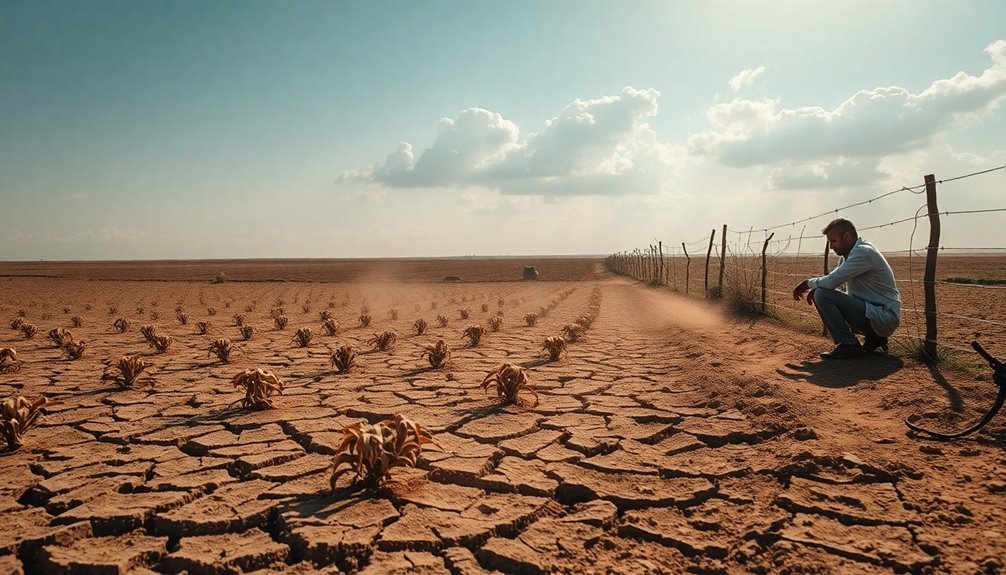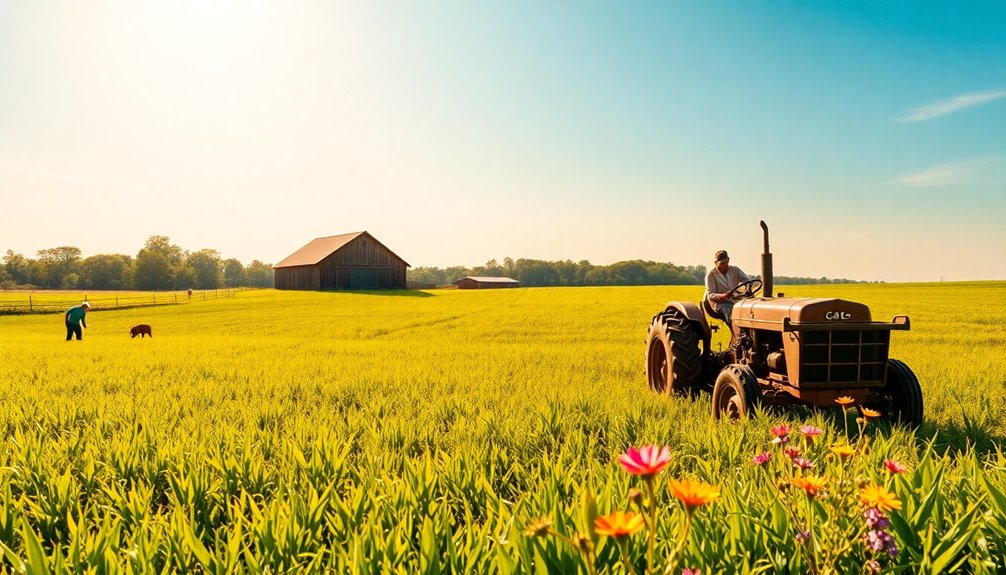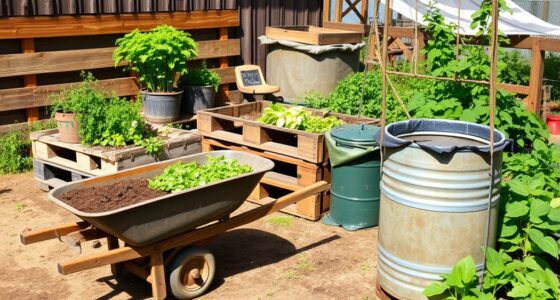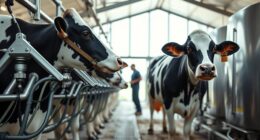Industrial farming's a large-scale agricultural system aimed at maximizing food output. You'll notice it relies heavily on synthetic fertilizers and chemical pesticides, which can boost production but often harm the environment. This type of farming typically involves monoculture practices, reducing biodiversity. While it lowers food prices and creates jobs, it also raises health and safety concerns, like pesticide exposure and antibiotic resistance. Additionally, it can threaten small farms and local economies. Understanding the balance of industrial farming's benefits and drawbacks is essential, and there's much more to explore on its broader impacts and alternatives.
Key Takeaways
- Industrial farming is a large-scale agricultural system focused on maximizing crop output through technology and synthetic inputs.
- It significantly boosts food production efficiency, leading to lower consumer prices and increased job opportunities in agriculture.
- Environmental challenges include soil degradation, water pollution, and reduced biodiversity due to heavy reliance on chemicals and monoculture practices.
- Health and safety concerns arise from chemical residues, foodborne illnesses, and antimicrobial resistance linked to industrial farming practices.
- The economic impact favors large-scale farms, often sidelining small farms and threatening local economies and job availability in the agriculture sector.
Definition of Industrial Farming
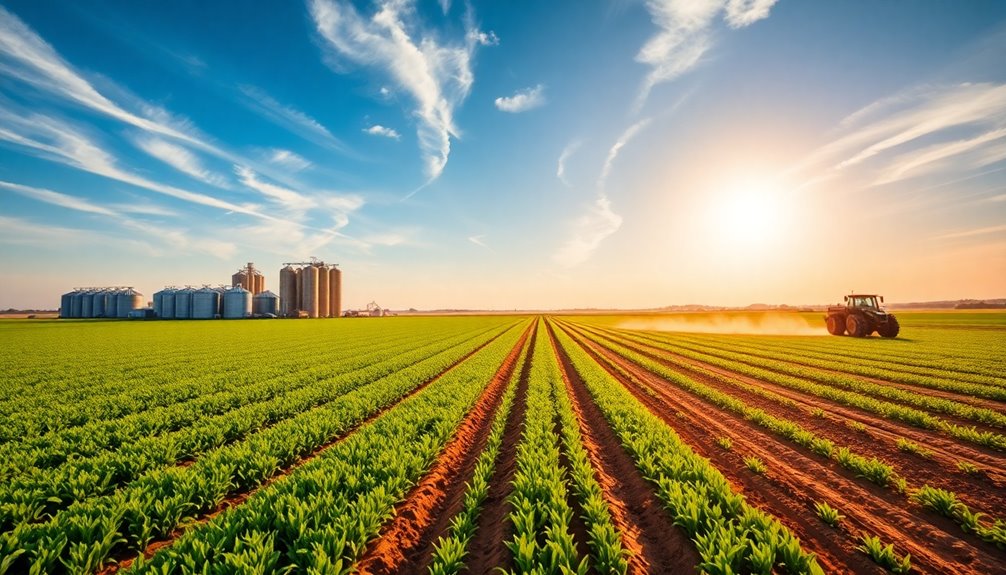
Industrial farming is a large-scale agricultural system designed to maximize output by cultivating crops and livestock at high densities, often using advanced technology and mechanization.
You'll notice that this method of industrial agriculture greatly boosts food production, allowing large farms to produce more food faster than traditional practices. However, it heavily relies on synthetic fertilizers and chemical pesticides, which have dramatically increased over the years.
For instance, nitrogen fertilizer application rose from 8.62 kg/ha in 1961 to 69.78 kg/ha in 2019. This approach typically involves monoculture, where only a few crop species are grown, leading to a decline in agricultural biodiversity.
Shockingly, only 150-200 out of approximately 250,000-300,000 crop species are commonly used in this system.
Advantages of Modern Agriculture

Modern agriculture offers several key advantages that directly impact you as a consumer.
It boosts food production efficiency, which means more food is available at lower prices.
Plus, it creates job opportunities in the agricultural sector, contributing to the economy while meeting your food needs.
Enhanced Food Production Efficiency
Advancements in agricultural practices have ramped up food production efficiency, allowing farms to keep pace with the demands of a growing global population. Through the use of chemical fertilizers and precision agriculture technologies, you can witness significant increases in crop yields.
Large-scale farming operations often focus on a few high-yield crop species, utilizing monoculture to streamline processes and reduce competition.
- Drones and data analytics enhance resource management.
- Economies of scale lower production costs.
- Synthetic fertilizers greatly boost crop growth.
These innovations not only improve the efficiency of food production but also contribute to a more sustainable approach to meeting the global food demand, ensuring that farms can provide enough for everyone.
Lower Consumer Prices
The benefits of industrial farming are evident in the lower prices consumers enjoy at the grocery store. By leveraging economies of scale, industrial farming achieves mass production efficiencies that lead to decreased consumer prices. Technological advancements, like precision farming and genetically modified organisms (GMOs), boost food production and cut costs. Large-scale farms produce food faster and minimize spoilage, ensuring a consistent supply and stabilizing market prices. Here's a look at how industrial farming impacts consumer prices:
| Factor | Impact on Consumer Prices | Example |
|---|---|---|
| Economies of Scale | Lowers prices | Bulk purchasing |
| Technological Advancements | Increases yield | GMOs improving crops |
| Efficient Processing | Reduces waste | Quick transportation |
| Mass Production | Stabilizes supply | Consistent availability |
| Agricultural Intensification | Enhances efficiency | Higher output |
Job Creation Opportunities
Industrial farming creates numerous job opportunities, making it an essential component of the agricultural economy. It directly provides approximately 1.3 million jobs in the U.S. agricultural sector, particularly in rural areas.
The economic impact of industrial farming extends beyond the fields, supporting job creation in:
- Food processing and distribution
- Machinery manufacturing and logistics
- Skilled labor roles in technology and management
Despite automation's rise, industrial agriculture still generates diverse employment opportunities.
The mass-scale production lowers consumer costs, boosting local economies and encouraging growth in service sectors linked to agriculture.
Environmental Challenges
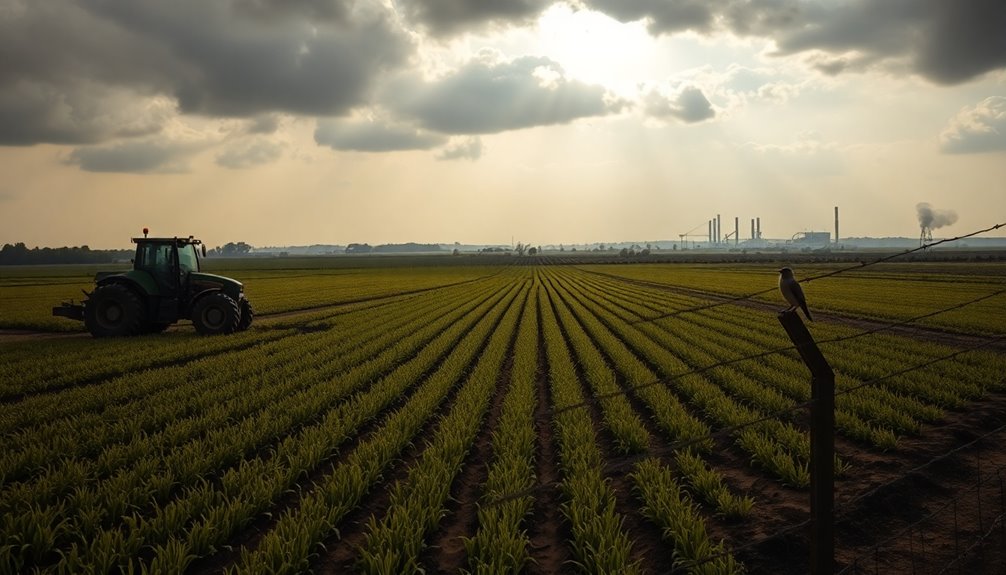
Environmental degradation stemming from modern farming practices poses significant challenges that impact both the planet and our health.
Industrial farming heavily relies on synthetic fertilizers and pesticides, which lead to soil degradation and water pollution. You mightn't realize that these fertilizers can cause harmful runoff, contaminating local waterways and disrupting aquatic ecosystems.
Furthermore, monoculture practices diminish biodiversity, as only a few crop species are cultivated, reducing ecosystem resilience.
The agricultural sector also contributes to water scarcity, with intensive irrigation draining freshwater resources and harming surrounding ecosystems.
Finally, it's crucial to note that about 80% of antibiotic sales in the U.S. stem from livestock production, raising concerns about antimicrobial resistance and its broader environmental implications.
Health and Safety Concerns

While many people may not realize it, industrial farming raises serious health and safety concerns that affect us all. The widespread use of chemical fertilizers and pesticides in industrial agriculture can lead to harmful residues in our food, contributing to issues like endocrine disruption and increased cancer risks.
Additionally, large-scale production methods heighten the risk of foodborne illnesses, with outbreaks often linked to centralized processing. Antimicrobial resistance is another critical concern, with an estimated 700,000 deaths annually due to infections resistant to treatment, partly driven by antibiotic use in livestock.
Moreover, the reliance on monoculture diets exacerbates nutritional deficiencies, leading to obesity and malnutrition in affected populations.
- Increased risk of foodborne illnesses
- Developmental delays in children from pesticide exposure
- Rising antimicrobial resistance affecting public health
Economic Impact on Communities

The economic impact of industrial farming on communities is profound, shaping both local economies and the livelihoods of those within them.
While industrial agriculture boosts national GDPs and lowers food costs, it often sidelines small farms. These small farms, despite comprising 72% of total farms, occupy only 8% of land, highlighting significant inequality in land distribution and economic power.
As large-scale industrial farms dominate the market, they drive many small farms out of business, leading to economic decline in rural areas.
Though industrial farming creates employment opportunities for millions, increased automation threatens long-term job availability.
Ultimately, the balance between supporting local economies and the rise of industrial farming poses a complex challenge for communities endeavoring to maintain their agricultural heritage.
Alternatives to Industrial Practices
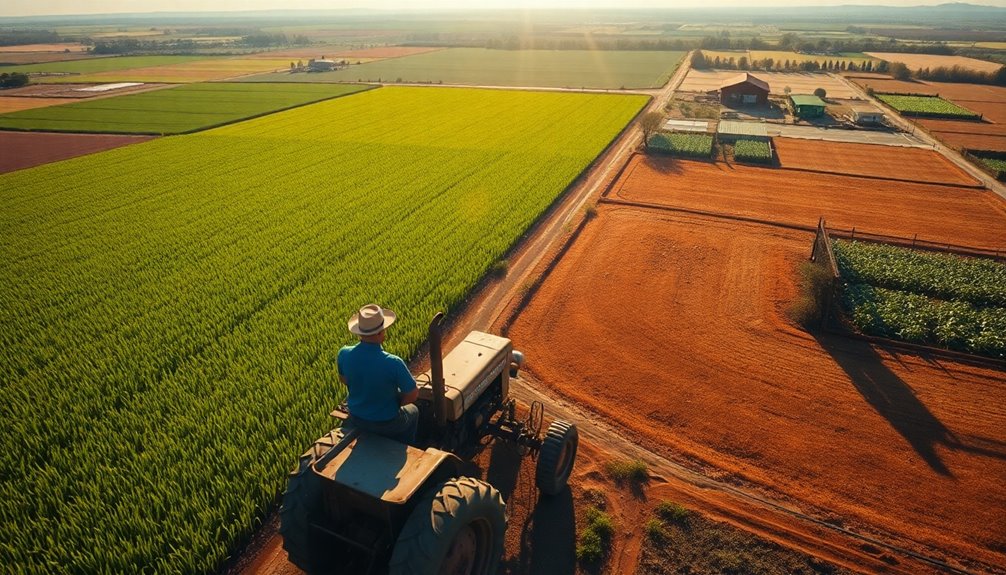
As communities seek to break free from the constraints of industrial farming, various sustainable alternatives are gaining traction.
You can explore options like organic farming, which focuses on soil health and biodiversity without synthetic chemicals. Community-supported agriculture (CSA) allows you to buy directly from local farmers, promoting fresh, seasonal produce and enhancing food security.
Consider these alternatives:
- Agroforestry: Integrates trees and crops, improving biodiversity and soil health.
- Permaculture: Designs farming systems that mimic natural ecosystems, conserving water and recycling waste.
- Urban agriculture: Enables you to grow food in small spaces, reducing reliance on industrial supply chains.
Frequently Asked Questions
What Is Modern Industrial Farming?
Modern industrial farming's all about large-scale operations that utilize advanced technology and mechanization to boost productivity.
You might notice the focus on monoculture, which means growing a single crop repeatedly, often leading to increased chemical fertilizer and pesticide use.
This approach has dramatically reduced the number of farmers, with only a small percentage now involved in agriculture.
While it maximizes efficiency, it raises concerns about environmental impacts and biodiversity loss.
What Is the Impact of Industrialization on Agriculture?
Industrialization in agriculture has drastically transformed food production, making it more efficient but also raising concerns.
You might notice that large-scale farming favors monocultures and synthetic chemicals, which can harm the environment and human health. It also leads to fewer farms, concentrating power in the hands of a few corporations.
While it's increased overall food availability, it often prioritizes animal feed over diverse crops, resulting in rising malnutrition and biodiversity loss.
What Is the Impact of Modern Farming?
Modern farming impacts you in various ways. It boosts food production, making groceries more accessible and affordable.
However, it also raises concerns about environmental health, as reliance on chemicals can harm ecosystems. You might notice the loss of biodiversity and soil quality in your area.
Additionally, the use of antibiotics in livestock can lead to health risks, including antibiotic resistance.
Balancing productivity and sustainability is essential for your future food security.
How Did the Industrial Revolution Affect Modern Agriculture?
The Industrial Revolution transformed modern agriculture by introducing mechanization, which greatly boosted productivity.
You'd notice that tasks like sowing and harvesting became quicker and easier with machines.
As synthetic fertilizers and pesticides emerged, farmers enhanced crop yields and tackled pests more effectively.
However, this shift led to larger farms and the dominance of a few agribusinesses, reshaping the landscape of food production and raising concerns about environmental sustainability.
Conclusion
Ultimately, while industrial farming has its advantages, like increased food production, it also poses significant challenges to our environment and health. Did you know that about 70% of the world's freshwater is used for agriculture? This statistic highlights the urgent need for more sustainable practices. By exploring alternatives, you can contribute to a healthier planet and community. It's time to rethink our approach to farming and support methods that prioritize both people and the planet.



